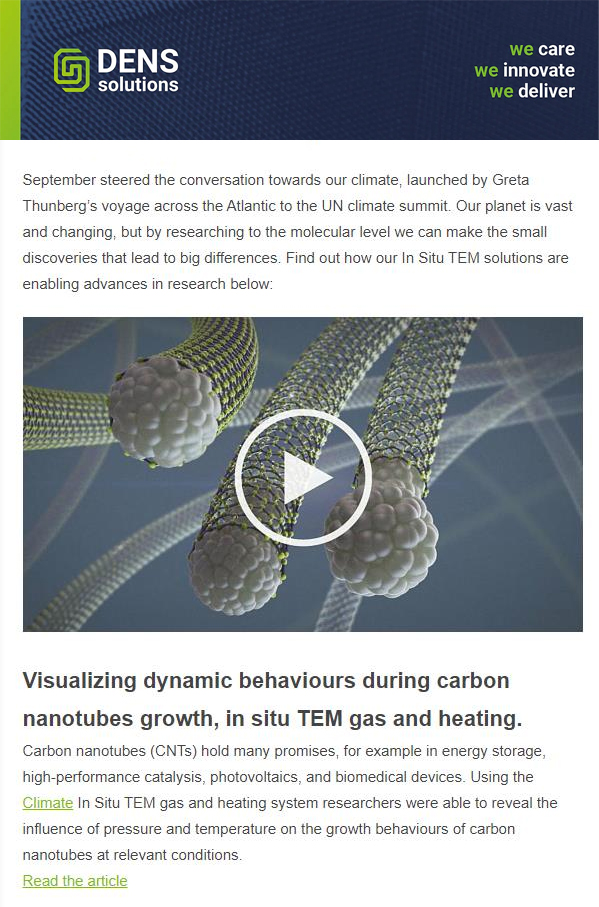
DENSsolutions has installed yet another Stream system in Germany at Forschungszentrum Jülich

From left to right: Andreas Körner and Dr. Andreas Hutzler
We are proud to announce that DENSsolutions has installed yet another Stream system in Germany at the esteemed Forschungszentrum Jülich, one of the largest interdisciplinary research centres in Europe. In this article, we interview Dr. Andreas Hutzler, the new head of the TEM lab in the Helmholtz Institute Erlangen-Nürnberg for Renewable Energy (HI ERN) at Forschungszentrum Jülich, to learn more about their advanced microscopy facility, its research direction, as well as how our Stream system is advancing their research.
Can you tell me more about the microscopy facility at HI ERN?
“The Helmholtz Institute Erlangen-Nürnberg for Renewable Energy (HI ERN) is part of the Forschungszentrum Jülich. It specializes in providing crucial research on technologies needed to utilize renewable energies in the decades to come. Our research is centered around fuel cells, electrolyzers and hydrogen storage. The institute was founded in 2013 and has been growing ever since. In 2021, its new research building was inaugurated, hosting the space for a new transmission electron microscope, the Talos F200i from Thermo Fisher Scientific. This tool provides in-house structural analysis on the nanoscale for catalysts, support systems and membranes.”
What type of applications are the users at HI ERN using the Stream system for?
“Our goal is to study electrochemical processes taking place on electrode and catalyst surfaces within electrolyzers and fuel cells down to the atomic scale. We aim to understand which reactions take place, and which conditions enhance the performance of the cells or disintegrate the structures involved.
In order to understand this, we consider beam-induced effects onto the solution chemistry we investigate. For this, we utilize a comprehensive radiolysis model for unraveling the influence of electron irradiation onto the sample and compare the results to non-biased experimental observations. Once this is understood, we continue with analyzing dynamic processes at the nanoscale to gain insights into reaction pathways and degradation mechanisms in P2X and X2P applications.”
What particular features of the DENSsolutions Stream solution attracted you to the system?
“In order to understand observable processes and their correlated chemistry, it is necessary to accurately tune experimental conditions while operating the system. The ability of the Stream system to flexibly adjust pressure, flux, temperature and potential allows to run a manifold of experiments in a wide parameter space. This is needed in order to verify the stability of our reaction kinetic models and for testing electrolysis at borderline conditions. Before, the structures could only be studied after the reaction has taken place. But the ability to directly observe dynamic processes on-site in real time gives valuable insights in the chemistry at hand.”
Can you tell me about the grant that was won to acquire the system?
“One of our key research interests is the development of new methods for characterizing fundamental and applied processes in electrocatalysis relevant to electrochemical energy conversion. After establishing identical-location TEM (IL-TEM) for energy applications and with the start of my team, a new transmission electron microscope as well as equipment needed for in situ liquid-phase TEM was funded by and installed at HI ERN. This particular toolbox will be a great asset for the nanoanalysis of electrochemical processes in my team which will enable unique insights in energy research.”
In your experience so far, how have you found the Stream system?
“The modular architecture of the Stream system enables a very versatile applicability without risking leakage or cross-contaminations. The performance of LP-TEM is considerably enhanced due to the controllability of liquid flow, the ever-present window bulging via the utilization of a novel chip design as well as a differential pumping system as a standard. Moreover, DENSsolutions came forward with providing non-standard solutions in order to provide compatibility with other setups at our institute.”

Head of the Transmission Electron Microscopy lab| HI ERN, Forschungszentrum Jülich
Dr. Andreas Hutzler is the new head of the Transmission Electron Microscopy lab at HI ERN, PI of multiple projects at HI ERN and university and is currently setting up a team for nanoanalysis of electrochemical processes. His research interests mainly focus on methodological aspects of LP-TEM and its application in electrochemical energy conversion.
Discover Dr. Andreas Hutzler’s publications:
Learn more about Stream:
Discover publications made possible by Stream:

